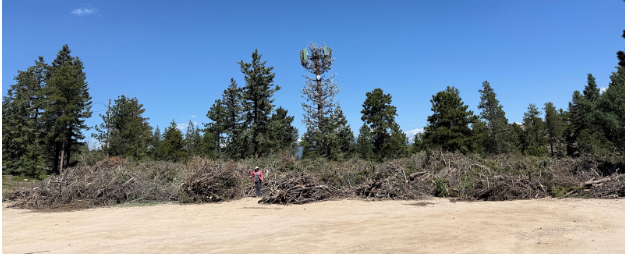Mitigation comes in a variety of shapes, sizes, and flavors
- Chris Reichard
- Aug 1
- 3 min read
By Chris Reichard, CCCFPD CWPP Implementation Committee
As our CWPP journey continues, we wanted to talk about “big projects” and why they happen. What do we mean by big? While many of us are familiar with mitigation focused on a single house, big projects usually involve several tens to hundreds of acres, or in miles for roadside mitigation. The CWPP has multiple objectives and identifies how to reduce wildfire risk to people, homes, and the forest landscape. Achieving multiple objectives requires many different tools. Mechanics and carpenters use numerous tools to fix cars and build houses. We need multiple tools to achieve the CWPP objectives and “big projects” are an important tool in the box. Residents rightly focus on making houses fire resistant and improving conditions in the Home Ignition Zone. This is where homeowners should continue to focus. But in addition, we also need to improve forest and wildfire fuel conditions over larger areas than one homeowner can achieve. Luckily there are larger public and private landowners in and near our community that are able to make these landscape scale improvements. There are numerous forestry organizations, government agencies, and watershed groups developing and implementing bigger projects for community-level benefit.
Why are these necessary? Most Front Range forests, Coal Creek Canyon included, are in a condition where out of control high severity fires are a real risk. Forest and fire managers promote the need to “increase the scale and pace of action” and big projects do that. The current amount and density of forest fuel in our area makes any wildfire unacceptable. Far too many trees, dense and continuous forests over large areas, high amounts of ground surface fuel, and interlocking/touching trees with few gaps create this high-risk situation. Colorado has many great minds studying this issue and research indicates that today’s forests are very different from the past, in large part because humans have been so successful at putting out most wildfires for over a century. Many of our present ponderosa and mixed conifer forests are two to three times denser today than in the past. And importantly, this is not a dead tree problem but a live tree problem. Periodic wildfires in the past kept forests in balance and served as trash collection service for the forest by burning off surface litter, small trees, and downed wood. As humans reduced fire frequency, forests kept growing denser, trees kept dying, pine needles kept falling, and downed wood kept accumulating. Imagine how your property would look if you stopped disposing of your trash for a century! Hard to picture.
The good news is that we know what to do and science-based forest management moves forests back towards historic, less risky conditions. Restored forests are less likely to experience high severity crown fires, they improve suppression opportunities for fire fighters, they can make evacuations safer, and they also protect the forest itself while improving wildlife habitat. Ponderosa pine and older Douglas fir can partially catch on fire and survive due to thick bark which insulates the living part of the tree. However, high intensity fires in dense crowded forests overwhelms this fire adaptation and we continue to lose ponderosa pine forests to wildfires.
Now the tough part of the discussion. Modifying forests towards historic conditions involves cutting trees, in some places a lot of trees, and not just dead ones. Forests will look different afterwards. Historic western forests were more open, less dense, and patchy across the landscape. Meadows were more common. Public reactions to these “big projects” can be poor and this is particularly relevant to lodgepole pine forests that need different management than ponderosa and mixed conifer forests. Patch cuts are typical in lodgepole forests because of how they grow and their high blow down risk when “thinned”. But we need to remember what we are up against. The recent wildfires in Colorado and other western states are highly aggressive, disruptive, and people hate the results. So rather than viewing big projects as too much or too aggressive, we should view them as recognizing the size of the enemy and acting accordingly. Tackling big problems and aggressive fires requires us to respond in-kind with our mitigation efforts. It’s not an exaggeration that our lives, homes, and forests depend on it. Next time you meet a forester, thank them.


Comments